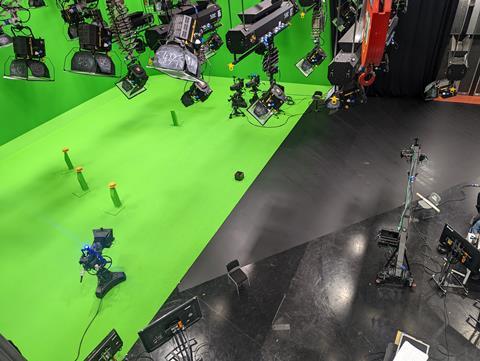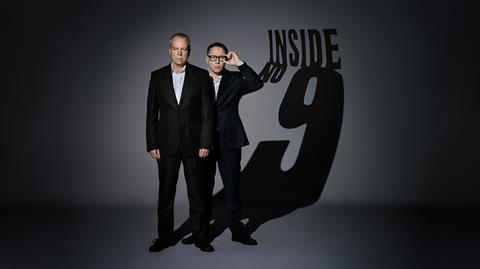Filmed at dock10, the episode made use of virtual studios’ flexibility

Facility dock10 has revealed how it facilitated an episode Inside No. 9, which surprised fans with an unexpected quiz show.
Viewers expected previously advertised episode called Hold on Tight that was billed as set on a bus on 18 May, but were told that a technical difficulty meant it couldn’t be shown and that a new quiz show pilot featuring comedian Lee Mack would air instead.
What came up on screen next looked and sounded, to all intents and purposes, exactly like a quiz show. Lee Mack was presenting from a proper quiz show set. However, it was actually an episode of Inside No. 9.
Listing magazines and EPGs all received information advertising the ‘ghost’ Hold on Tight episode. A poster was even created for it. However, the production was actually at work on the quiz episode.
The first reaction of the production team when told by Reece Shearsmith and Steve Pemberton that they wanted to write a quiz show episode was that it would be prohibitively costly to make. Physical sets for quiz shows are expensive to build, and traditionally pay for themselves over the long run by being used for multiple series. As such, they looked at a virtual studio.

Eirwen Davies, production executive for comedy at Inside No. 9 producer BBC Studios Productions, said: “dock10 said they had a virtual prototype for a quiz show that we could look at and adapt for our own needs. And that is what did. We adapted their virtual quiz show set.”
Director Barbara Wiltshire, who earlier worked on a surprise Halloween episode of Inside No. 9, returned, and working alongside executive producer Adam Tandy. Filming took place over two days at dock10, and the set itself was almost entirely virtual. Each of the contestants (who were in fact actors) had a physical buzzer in front of them that they could press. Apart from the buzzers, much of the set was digitally created – and was composited into the shots in real time during production.
Davies said: “If I looked at the studio, there was literally nothing there. Then I’d look at the comped in shots [on the monitor] with the entire set in it. It blew my mind!”
She pointed to the flexibility of virtual studios compared to traditional multi-camera operations: “They can be quite a beast and can take a while to build momentum. It’s like a machine you are bringing into life in a studio. And this was actually easier.”
“If you were filming a quiz show in a traditional multicamera studio, you’d run it as live from beginning to end to keep the momentum going, and then go back in for some pick up shots. Because this was virtual, and there was very little in the studio, we were able to do lots of different passes. It was almost a bit like a hybrid between a multicamera and a single camera set up.”

She added: “On a physical set, you can only really point the cameras in a certain direction – in our case at Lee Mack or at the contestants. You can’t shoot off to the side or shoot up. If you do, it becomes very expensive in the edit to create set extensions. But with a virtual set, we found we had more flexibility. You can just say, ‘We want to shoot this way. Can we just put a bit more green for the virtual set over here?’”
Davies did have some worries before production: “I was concerned that, although this looks like a quiz show, it isn’t – it’s a narrative comedy. And I’ve always thought that narrative comedy can’t be done virtually. I’d thought that actors need to be able to interact with other actors in a physical set. For some actors, their character doesn’t come alive until they are actually standing on a set in their costume.”
Most of the work on the set was carried out during the pre-production stage. Producer Kim Crowther and production designer Paul Rowan visited dock10 for a demo, and then there were regular meetings with dock10 virtual studio specialists who helped to adapt their virtual quiz show prototype. There were also a few Zoom calls with director Wiltshire so she could set up her camera plan for the shoot.
Davies noted that this helped with budgeting: “I knew that once we agreed the cost for the virtual set, I wasn’t going to run into other money problems. Whereas on a multicamera studio, you are always worried about the set being in in time, and if they have managed to light it. If not, there can be a domino effect.”





























No comments yet